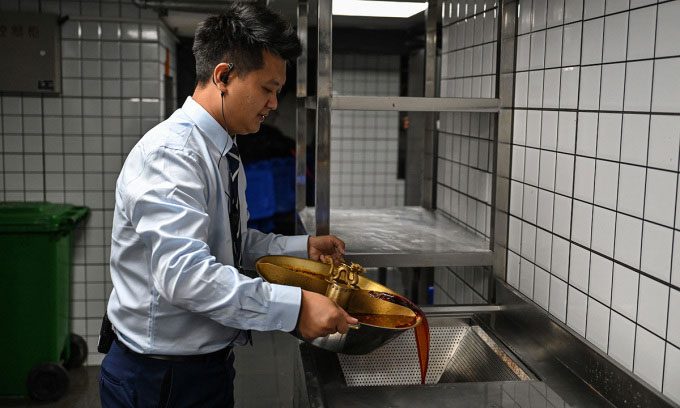Every night, excess oil from restaurants is filtered, collected, and transported to a factory on the outskirts of Chengdu for refinement into industrial oil.
The company Sichuan Jinshang Environmental Protection (SJEP) has developed a process to handle large amounts of used hot pot oil that is discarded and converted into aviation fuel, AFP reported on November 21. According to director Ye Bin, the company is producing up to 150,000 tons of industrial oil annually from hot pot restaurants and other eateries in Chengdu.

Restaurant staff in Chengdu pouring hot pot broth mixed with oil into a filter funnel for recycling. (Photo: AFP).
Typically, in the evenings after customers leave, restaurant servers begin pouring the hot pot broth into a special filter to separate the oil from the water. Next, collectors hired by SJEP, wearing thick aprons and elbow-length rubber gloves, come to take the containers of greasy oil. They may visit hundreds of shops in one night.
The hot pot oil is then transported to an industrial zone on the outskirts of the city, where SJEP’s factory is located. The oil is directed into large containers and undergoes a refining process to remove any remaining water and impurities, resulting in a clear yellow industrial oil. This fuel will be exported to clients, primarily in Europe, the United States, and Singapore. It will be further processed to create “sustainable aviation fuel” (SAF).
SAF plays a crucial role in reducing carbon emissions in the aviation sector, which contributed 2% of global CO2 emissions in 2022, according to the International Energy Agency (IEA). However, this type of fuel is still not widespread, accounting for less than 0.1% of total aviation fuel consumed, due to high processing costs and a limited number of suppliers.
The International Air Transport Association (IATA) estimates that widespread use of SAF could contribute approximately 65% to emission reductions, helping the aviation industry achieve net-zero emissions by 2050. SJEP also plans to develop its own SAF production facility, using equipment from the American company Honeywell to produce 300,000 tons annually.
SJEP’s operational model is part of China’s efforts to tackle the massive food waste generated by its 1.4 billion population. According to a 2021 study published in the journal Nature, around 350 million tons of agricultural products—more than a quarter of annual production—are wasted in China due to being discarded by restaurants, supermarkets, or consumers.
At landfills, rotting food waste generates methane, which warms the atmosphere faster than most other materials, according to the U.S. Environmental Protection Agency. This is a significant issue for Chinese cities and poses a major threat to global climate goals. China has committed to addressing this issue with a plan to reduce methane emissions, calling for the deployment of innovative food waste processing projects across the country in the coming years.


















































